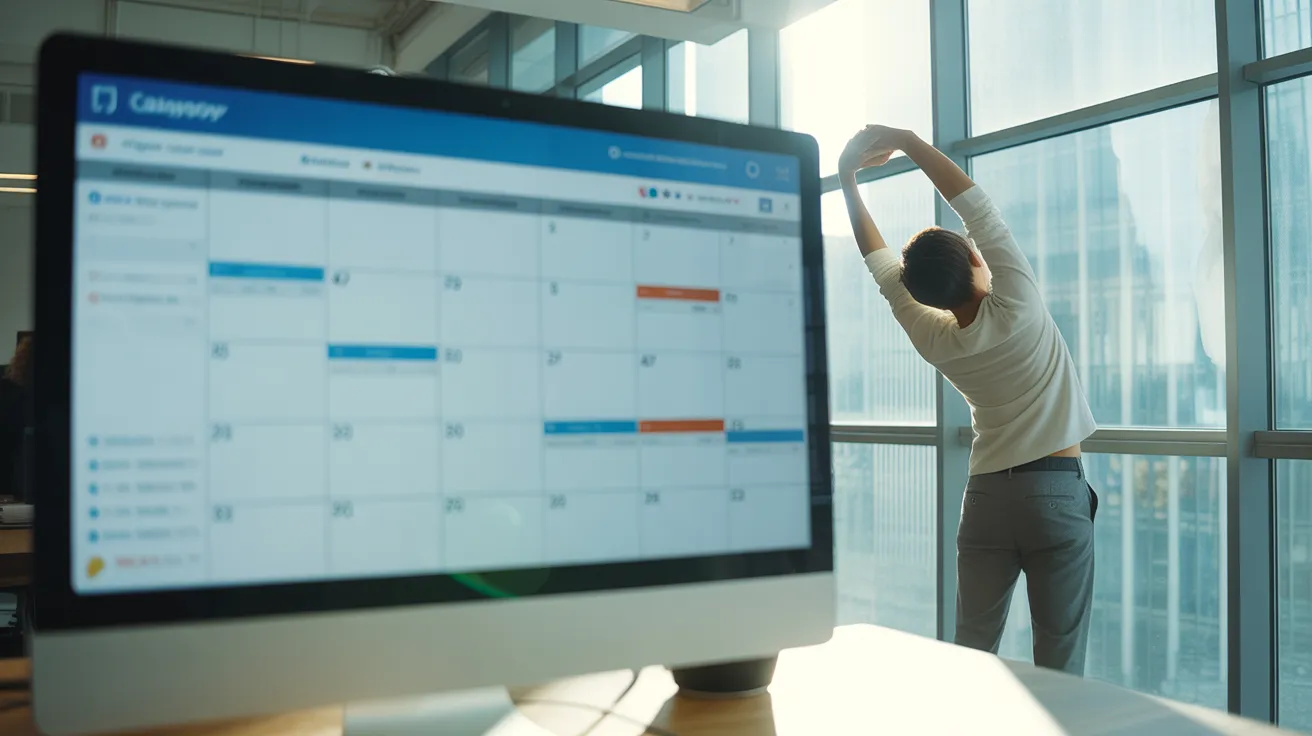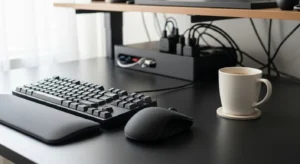
We’ve all been there. Staring at a blank page, a messy desk, or an overflowing inbox. We know what we should do. We have the knowledge, the tools, and the time. Yet, a powerful inertia holds us captive. It’s the gap between intention and action, a canyon where motivation goes to die.
For years, the productivity world sold us on heroic effort. It told us to find more willpower, to hustle harder, to optimize every waking second into a perfectly calibrated machine. But this approach often leads to burnout, not breakthroughs. True, sustainable productivity isn’t about becoming a robot; it’s about understanding your own human wiring and using small systems to outsmart your own resistance.
This is where the magic of micro-habits and simple triggers comes in. Instead of trying to summon a tidal wave of motivation, you just need to create a single ripple. One of the most powerful ripple-makers ever conceived is not a complex app or an expensive planner. It’s a simple countdown.
Welcome to the 5-Second Rule. This isn’t just another productivity hack; it’s a tool for metacognition, a way to seize control of your mind in the very instant that hesitation tries to take over. It’s the key to learning how to make fast decisions—not rash ones, but the small, crucial decisions that propel you into action.
📚 Table of Contents
- What Is the 5-Second Rule? (And Why It Works)
- Putting the Rule to Work: Your First Micro-Habits
- The Tools of Instant Decision Making
- Your Calendar is Your Fortress
- Timers Are Your Pace-Setters
- Mastering the Snippet: A Mini Time Audit
- Compounding Your Wins: Chaining Habits and Avoiding Pitfalls
- The 5-Second Rule in Action: Two Scenarios
- Frequently Asked Questions About Instant Decisions
- Is this just a glorified version of “just do it”? Where does willpower fit in?
- What’s more important: the tools like calendars and timers, or the habit of using the rule?
- I’m worried about the “switching cost.” Doesn’t making instant decisions to change tasks hurt focus?
- Are there times when I should *not* use the 5-Second Rule?
- What if I try a micro-habit, like the desk reset, and it doesn’t seem to work for me?
- Your First Three Actions to Take Today
What Is the 5-Second Rule? (And Why It Works)
The 5-Second Rule was popularized by speaker and author Mel Robbins, who discovered it during a low point in her own life. The concept is breathtakingly simple: The moment you have an instinct to act on a goal, you must physically move within five seconds or your brain will kill the idea.
You feel you should speak up in a meeting. You know you need to get out of bed instead of hitting snooze. You see an opportunity to make a phone call you’ve been dreading. In that moment, you start counting backward: 5… 4… 3… 2… 1… GO. And on “GO,” you move. You don’t think. You don’t hesitate. You act.
It sounds almost too simple to be effective, but its power lies in solid neuroscience. Your brain is wired to protect you from risk, uncertainty, and effort. When you hesitate for even a few seconds, your prefrontal cortex—the part of your brain responsible for overthinking, analysis, and doubt—kicks into high gear. It floods you with a hundred reasons why you shouldn’t do the thing.
The 5 second rule mel robbins popularized is a cognitive trick. The act of counting backward requires focus. It distracts your brain from its default pathways of worry and excuse-making. It’s a starting ritual that interrupts the habit of hesitation and allows you to activate a different part of your brain, one geared toward action. It’s not about finding the courage; it’s about moving before the fear can find you.
This isn’t about making massive, life-altering choices in an instant. The 5 second rule is for breaking the habit of procrastination on the small things that, when compounded, create huge momentum. It’s the tool you use to close the gap between knowing and doing, making instant decisions to act on your best intentions.
Think of it as a launch sequence for your behavior. The countdown creates a moment of psychological pressure, a tiny, self-imposed deadline. And when you hit zero, you launch. You don’t launch into a perfect, flawless execution. You just launch into the first step.

Putting the Rule to Work: Your First Micro-Habits
The true power of the 5-Second Rule isn’t in using it once for a big, scary event. It’s in applying it dozens of times a day to build small, powerful, and sustainable habits that clear the friction from your life. Let’s look at a few high-impact micro-habits you can start today using this simple countdown.
The One-Screen Phone Tweak
Your phone is a universe of distraction, engineered to pull you away from what matters. The thought of taming it can feel overwhelming. So we don’t. We let the notifications and endless icons rule our attention.
Here’s the thought: “I should really clean up my home screen.” Immediately, your brain says, “That’ll take forever. Where do I even start?” Don’t let it win. The moment you have the thought, start the countdown.
5… 4… 3… 2… 1… Pick up your phone. Don’t plan the whole reorganization. Just press and hold one distracting app—a social media app, a game, a news aggregator—and move it off your main screen into a single folder on the second page. That’s it. You’re done for now.
Repeat this a few times a day. Soon, your home screen will contain only tools, not temptations. All the noisy apps will be tucked away in a single folder, requiring an intentional swipe and tap to access. You’ve used a five-second decision to reclaim hours of your focus.
The 10-Minute Desk Reset
A cluttered desk leads to a cluttered mind. You know this. You look at the pile of papers, the empty coffee mug, and the tangled cables and think, “I need to clean this up later.” Later never comes.
Instead, use the rule. The next time you glance at your messy workspace and feel that familiar sigh of resignation, interrupt it. 5… 4… 3… 2… 1… Stand up. Don’t think about the whole mess. Just set a timer on your phone for 10 minutes. For those 10 minutes, move with purpose. Put papers in a single pile. Throw away trash. Wipe down the surface.
When the timer goes off, you stop. You’ve created a pocket of clarity. You didn’t need two hours or a surge of inspiration. You just needed a five-second countdown to get you on your feet. Doing this at the end of every workday can transform your relationship with your workspace and your focus for the next morning.
The 15-Minute Weekly Review
Productivity isn’t just about doing more things; it’s about doing the right things. The weekly review is one of the most powerful habits for ensuring you’re on track. But it can feel like a chore. It’s easy to skip.
On Friday afternoon, your calendar pops up a reminder: “Weekly Review.” Your first instinct is to dismiss it. You’re tired. You want the weekend to start. This is the critical moment.
5… 4… 3… 2… 1… Open your calendar and a blank document. That’s the first step. You’ve committed. Now, set a timer for 15 minutes. In that time, answer three simple questions: What went well this week? What didn’t go as planned? What are my top 1-3 priorities for next week?
This simple act of reflection and intention, triggered by a five-second decision, prevents you from drifting. It ensures that each week is a conscious step forward, not just a reaction to whatever is screaming for your attention.

The Tools of Instant Decision Making
The 5-Second Rule is the ignition. It gets the engine started. But to actually drive somewhere, you need a steering wheel and a map. In productivity, your tools provide that structure. When you combine the countdown with simple, effective tools, you create a system for consistent action.
Your Calendar is Your Fortress
A to-do list is a collection of wishes. A calendar is a plan for action. The best way to use your calendar is through a technique called timeboxing. Instead of just listing “write report,” you block out a specific time on your calendar—say, Tuesday from 9:00 AM to 10:30 AM—and label that block “Work on Q3 Report.”
But even with a block on your calendar, the moment of transition is where procrastination strikes. At 8:59 AM, you’re tempted to check email one last time. This is where you deploy the rule. 5… 4… 3… 2… 1… Close your inbox. Open the report document. You’ve used the rule to honor the commitment you made to yourself. Your calendar isn’t just a suggestion box; it’s a fortress wall protecting your time, and the 5-Second Rule is the guard at the gate.
Timers Are Your Pace-Setters
Big tasks are intimidating. “Write a 10-page article” feels enormous. But “write for 25 minutes” feels manageable. This is the principle behind the Pomodoro Technique and other timer-based focus methods. Timers create a sense of gentle urgency and provide a clear finish line.
The 5-Second Rule is the perfect way to start a timer session. You know you need to work on a daunting project. Your brain starts inventing reasons to delay. 5… 4… 3… 2… 1… Start a 25-minute timer and begin. Don’t worry about finishing the project. Just work until the timer rings. The countdown gets you started, and the timer keeps you going, transforming a mountain into a series of small, walkable hills.
Mastering the Snippet: A Mini Time Audit
We often have no idea where our time truly goes. A time audit—the process of tracking your activities for a day or a week—is an eye-opening exercise. But the thought of logging every minute of your day can feel like a massive new project in itself.
So, don’t. Start with a snippet. Use the rule to conduct a one-hour audit. The thought comes: “I wonder where my morning is going.” Instead of letting it pass, act. 5… 4… 3… 2… 1… Open a notepad or text file. For the next 60 minutes, jot down what you’re doing every 15 minutes. That’s it.
This tiny, low-friction action gives you a real data point. You might discover you spent 40 of those 60 minutes reacting to emails and notifications instead of doing the deep work you had planned. This insight is gold. It’s the kind of clarity that fuels better decision making, and it all started with a five-second choice to stop wondering and start observing.

Compounding Your Wins: Chaining Habits and Avoiding Pitfalls
Once you’ve mastered using the 5-Second Rule to trigger individual actions, you can start to “chain” them together to build powerful routines. This is where small, consistent efforts begin to compound into massive results. It’s also where we must guard against the temptation to over-engineer our lives.
The concept is simple: use the momentum from one small win to launch you directly into the next. For example, your 10-minute desk reset ends. The timer goes off. Instead of just stopping, you immediately use a new countdown—5… 4… 3… 2… 1…—to open your to-do list and identify your single most important task for the next hour. You’ve chained a “clearing” habit to a “focusing” habit.
You can integrate this with other proven productivity frameworks. Consider the 1-3-5 Rule, a method for daily planning where you commit to completing one big task, three medium tasks, and five small tasks. The morning indecision about where to start is a classic procrastination trap. Use the 5-Second Rule to kill that indecision: 5… 4… 3… 2… 1… Start the first small task. The momentum you gain makes tackling the bigger items much easier.
Another powerful technique is batching. This involves grouping similar tasks together to minimize the mental cost of switching contexts. For example, instead of answering emails as they arrive, you schedule two 30-minute “email batch” sessions per day. The temptation to break this rule is immense. When you see a tempting notification, you use the 5-Second Rule to honor your system: 5… 4… 3… 2… 1… Acknowledge the email, but don’t open it. Get back to your planned task.
The Danger of Over-Optimization
As you integrate these systems, a new danger emerges: the trap of over-optimization. This is when you spend more time designing the perfect productivity system than actually doing the work. You create complex spreadsheets, try every new app, and constantly tweak your routines.
The 5-Second Rule is the antidote to this. Its entire philosophy is biased toward action. If you find yourself spending 30 minutes color-coding your calendar, that’s a signal. Use the rule on yourself: 5… 4… 3… 2… 1… Close the settings tab and start the actual work. The goal is not to have a perfect system; it’s to get things done. A “good enough” plan that you act on is infinitely better than a “perfect” plan that you endlessly refine.

The 5-Second Rule in Action: Two Scenarios
Theory is one thing; practical application is another. Let’s see how two different professionals might use the 5-Second Rule to transform their workdays and master the art of how to make fast decisions that lead to action.
Scenario 1: The Overwhelmed Manager
Meet Sarah, a department manager. Her calendar is a solid wall of back-to-back meetings. Her day is spent reacting to problems, answering questions, and feeling like she’s never actually moving her own projects forward. She feels perpetually behind.
The Snooze Button: Sarah’s alarm goes off at 6:30 AM. Her instinct is to hit snooze. But today, she tries something new. 5… 4… 3… 2… 1… She physically puts her feet on the floor. This single act gets her up 15 minutes earlier, giving her a quiet moment to review her priorities before the chaos begins.
The Unnecessary Meeting: An email arrives: “Quick Sync on Project X?” Sarah’s default is to say yes to avoid conflict. She knows the meeting isn’t necessary. She hesitates, her finger hovering over the “Accept” button. Instead: 5… 4… 3… 2… 1… She types, “Thanks for the invite! To keep everyone focused, can we handle this via email? Here are my updates…” She has just reclaimed 30 minutes.
The Drained Handoff: One meeting ends at 10:59 AM, and the next starts at 11:00 AM. She feels drained. The thought: “I need a break.” The resistance: “I can’t be late.” She uses the rule. 5… 4… 3… 2… 1… She stands up, stretches, and gets a glass of water. She joins the next meeting at 11:02 AM, but she is mentally present and refreshed, making the next 58 minutes far more effective.
Scenario 2: The Solo Maker with a Flexible Schedule
Now consider Ben, a freelance writer. His biggest challenge isn’t a packed schedule; it’s the opposite. He has a long, unstructured day and a list of important but not urgent tasks. His enemy is procrastination fueled by a lack of deadlines.
The Morning Deep Work: Ben knows he should tackle his most difficult writing task first thing in the morning. But the lure of checking stats, email, and social media is strong. He sits at his desk and feels the pull. 5… 4… 3… 2… 1… He launches a focus app that blocks distracting websites for 90 minutes. He hasn’t found motivation; he has created an environment for focus.
The Research Rabbit Hole: While writing, Ben needs to look up a fact. This is a dangerous moment. He opens his browser, and his brain wants to check the news or a favorite blog. He feels the impulse. 5… 4… 3… 2… 1… He closes all irrelevant tabs, finds the single piece of information he needs, and immediately closes the browser. He stays on task.
The Afternoon Slump: Around 2:00 PM, his energy crashes. His instinct is to scroll through his phone or make another pot of coffee. He knows a short walk would be more effective. “I should go for a walk.” The thought is there. 5… 4… 3… 2… 1… He stands up and puts on his shoes. He doesn’t debate it. He just moves. The walk recharges his brain, making the rest of his afternoon productive.

Frequently Asked Questions About Instant Decisions
As you begin to incorporate the 5-Second Rule, some common questions and sticking points may arise. Here are answers to a few of them.
Is this just a glorified version of “just do it”? Where does willpower fit in?
While the outcome is similar, the mechanism is different. “Just do it” relies on summoning a large amount of willpower to overcome resistance. The 5-Second Rule is a technique to act before that massive resistance fully forms. It’s not about being stronger than your excuses; it’s about being faster. It’s a tool that helps you bypass the need for heroic willpower on small, everyday actions, which in turn helps conserve your mental energy for bigger challenges.
What’s more important: the tools like calendars and timers, or the habit of using the rule?
The habit is primary. The 5-Second Rule is the engine. However, without tools, you’re just an engine revving in neutral. The tools—your calendar, timers, a clear to-do list—provide the destination and the roadmap. The rule helps you press the accelerator, but your tools tell you where to go. The most effective system combines the starting ritual of the rule with the structure of well-chosen tools.
I’m worried about the “switching cost.” Doesn’t making instant decisions to change tasks hurt focus?
This is a critical distinction. The 5-Second Rule should not be used to encourage random task-switching or distraction. It should be used to start a planned block of focused work or to return to focus after a distraction. You use it to honor the blocks on your calendar, not to abandon them. The goal is to make an instant decision to commit to a single task for a sustained period, thereby reducing switching costs.
Are there times when I should *not* use the 5-Second Rule?
Absolutely. The rule is for breaking hesitation and initiating action. It is not for major, life-altering decisions that require careful deliberation, research, and consultation. Choosing a career, making a significant financial investment, or deciding on a medical procedure are not things to be decided with a five-second countdown. Use the rule to start the process of researching those decisions, but not to make the final call impulsively.
What if I try a micro-habit, like the desk reset, and it doesn’t seem to work for me?
Quit. The goal of any productivity technique is to make your life easier and more effective, not to follow a dogma. If a specific hack or habit creates more friction than it removes, discard it without guilt. The 5-Second Rule itself is a meta-habit—a habit for starting other habits. Use it to experiment with different techniques until you find the handful that truly resonate with your workflow and personality. The purpose is results, not rigid adherence.
For further reading on the psychological mechanisms behind habits and cognition, resources from organizations like the American Psychological Association (APA) or the National Institutes of Health (NIH) can provide valuable scientific context.

Your First Three Actions to Take Today
Knowledge without action is just entertainment. The only way to see if the 5-Second Rule works is to apply it. Right now. Here are three simple, concrete actions you can take in the next few minutes to begin building momentum.
1. The 5-Minute Sprint. Think of one task you have been procrastinating on for a day, a week, or a month. It could be an email, a phone call, or the first paragraph of a report. Don’t think about finishing it. Just think about starting. Right now, count: 5… 4… 3… 2… 1… GO. Set a timer for five minutes and work on that single task. When the timer goes off, you can stop. You’ve broken the inertia.
2. The 10-Minute Tidy. Look at your immediate physical or digital environment. Is your desk cluttered? Is your computer desktop a mess of files? Choose one small area. Now: 5… 4… 3… 2… 1… GO. Spend just 10 minutes clearing that single space. Throw away trash, put things away, or organize files into a single “To Sort” folder. Create one small island of order.
3. The 15-Minute Block. Open your digital or paper calendar. Find a 15-minute slot sometime this Friday. Let’s make a commitment. 5… 4… 3… 2… 1… GO. Create an event in that slot and title it “Weekly Review.” You have just scheduled an appointment with your future self to be more intentional. That’s a huge win.
The 5-Second Rule is not a magic bullet, but it is a powerful catalyst. It’s a simple, repeatable system for overcoming the brain’s natural tendency toward hesitation. By using it to make instant decisions to act, you build trust in yourself, create momentum, and turn your best intentions into meaningful accomplishments, one countdown at a time.
Disclaimer: This article is for informational purposes only and does not constitute medical, legal, or financial advice. Please consult a qualified professional for advice tailored to your individual situation.






